Imóvel / instável, Galeria Luisa Strina, 2011
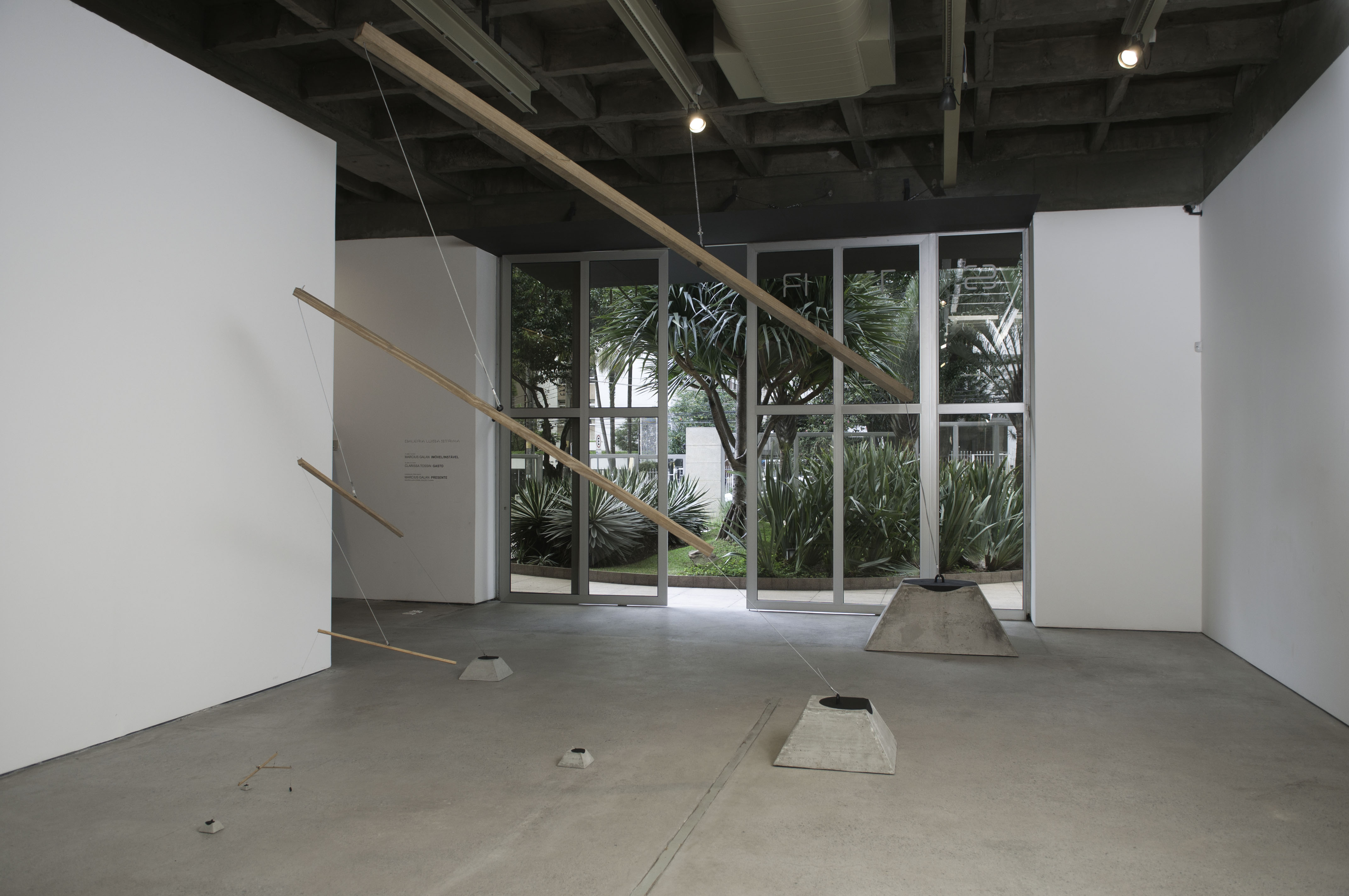
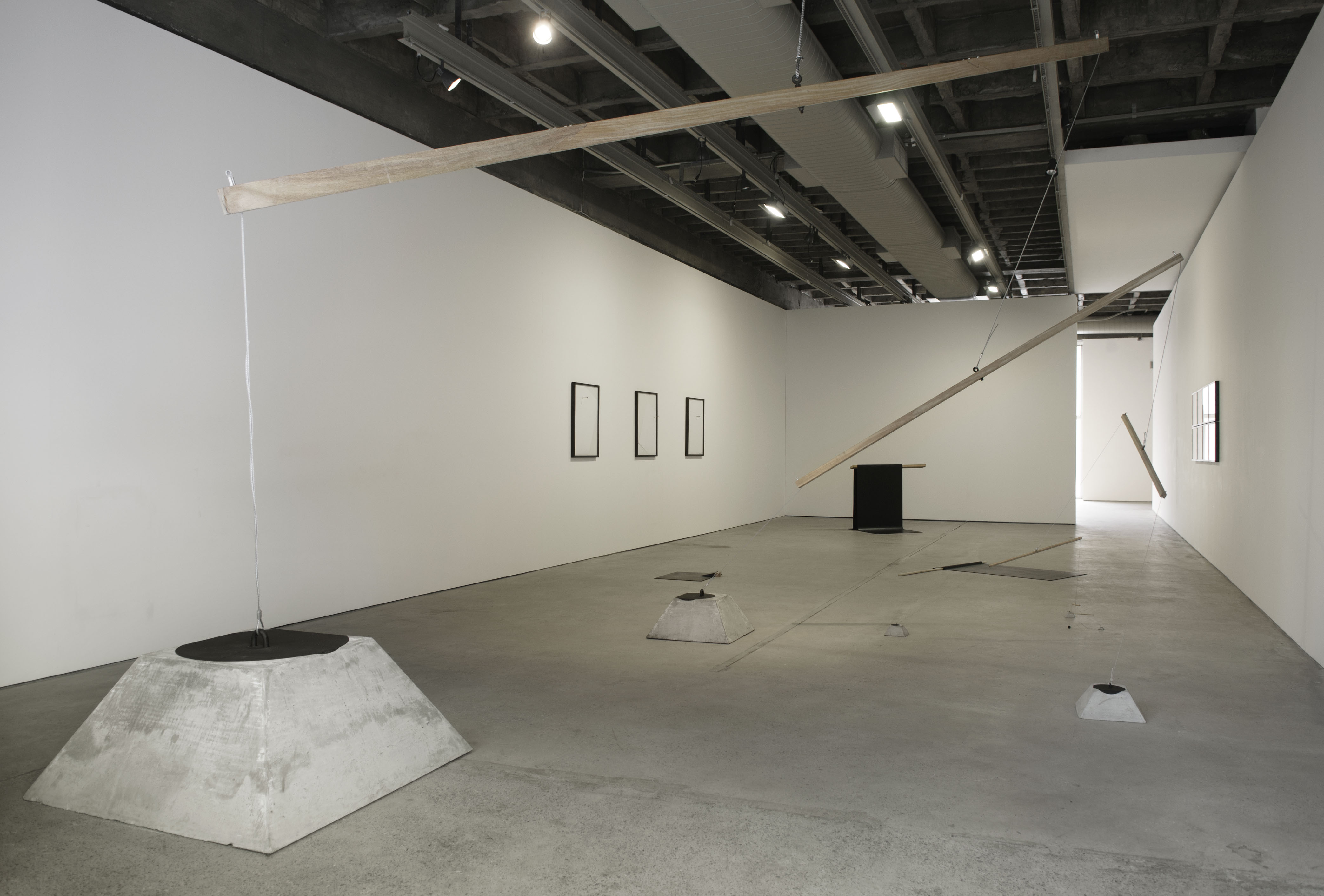
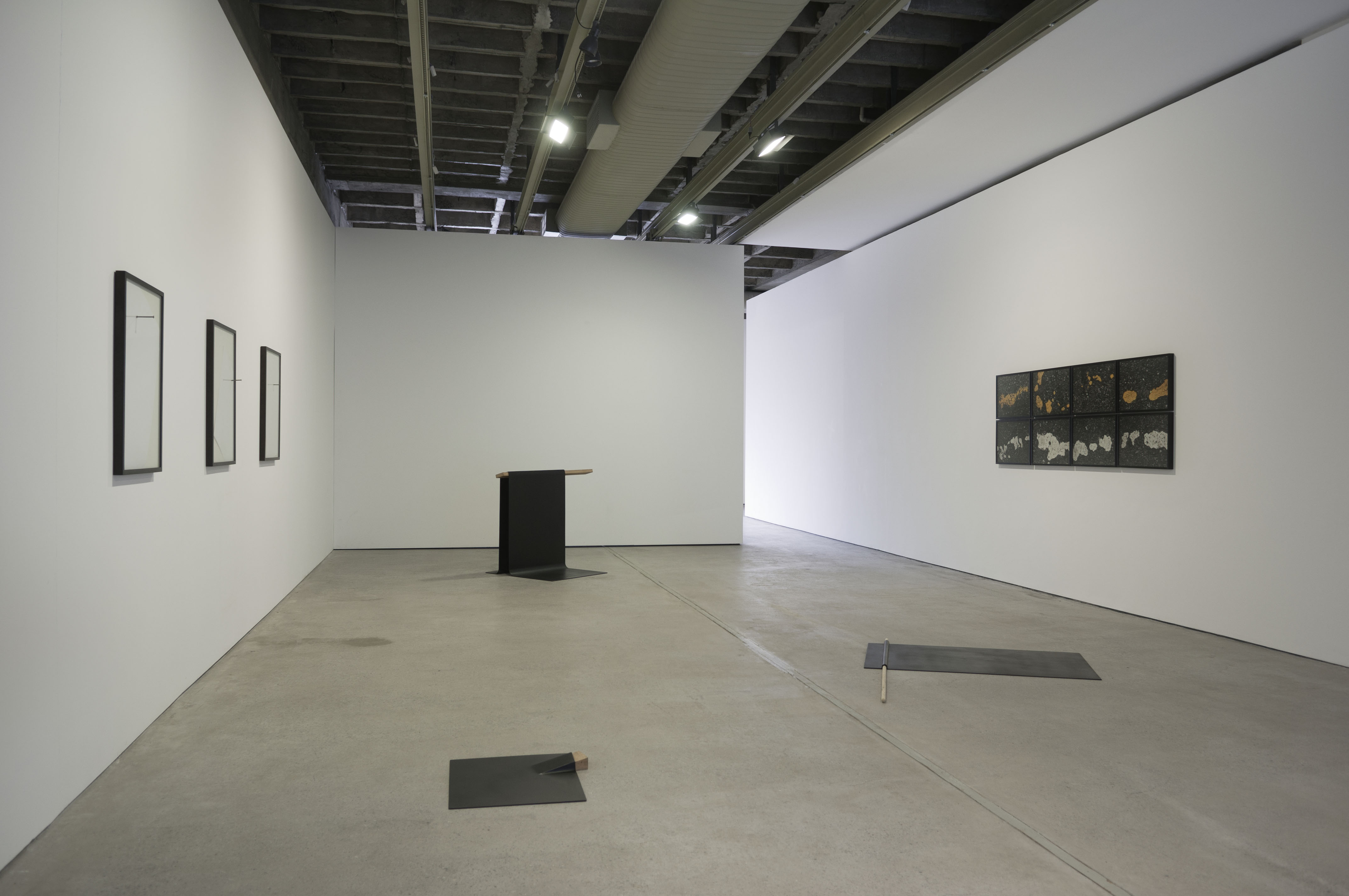

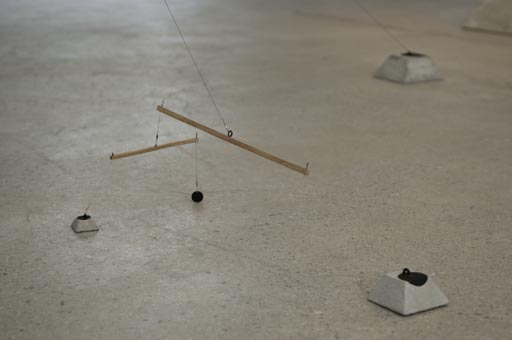
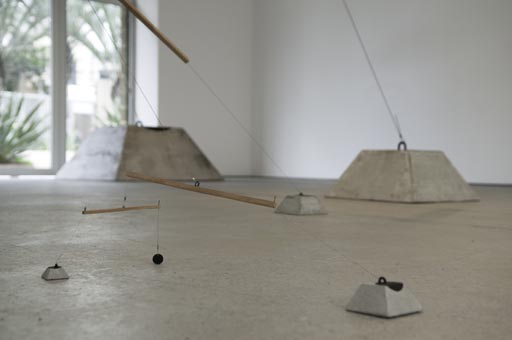
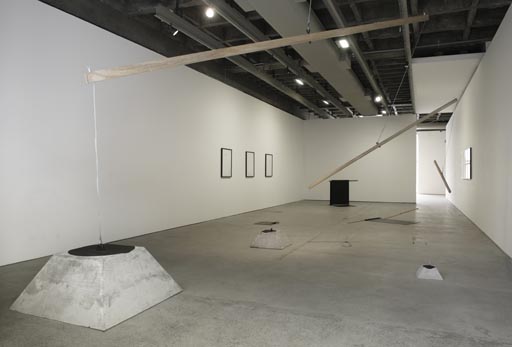
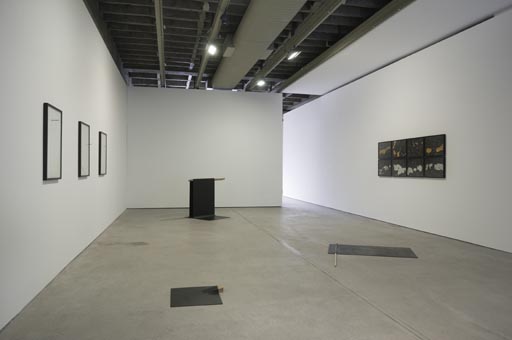
Solo exhibition
Galeria Luisa Strina, São Paulo, BR, 2011
Marcius Galan Exhibition from June, 28th to July, 30th, 2011.
IMMOBILE/INSTABLE Text by Luisa Duarte In ‘IMÓVEL/INSTÁVEL’ (IMMOBILE/INSTABLE), by Marcius Galan, at Galeria Luisa Strina, we find the presence of a work whose formal power is linked to content which is not less consistent and which acutely tells us about the time we live in. Such coalescence is rare and makes Galan’s work one of the most instigating happenings in the contemporary production. In the last ten years, the artist has been exhibiting series of work which only reinforce this certitude.
The exhibition begins with a large installation, after which the very exhibition was named. Resembling a mobile, the structure, however, does not move. The overhanging structures are anchored on the ground, making the composition which evokes movement still.
The design is made in such way that such fixity encompasses an element of crookedness. It is fixed, but there is no harmony, only unbalance. We look at the piece and it indeed has the nature of a mobile, but does not move; it is rigid, stuck and stable.
The weights which hold the structure are made in the shape of pyramids and dwindle from module to module. There is a sequence which decreases from the outside in. The first weights are up to 120cmX120cm in their base, reaching the point in which the support is given by a simple coin. Note that a coin has the same role, the same function, as a large block of concrete. In the end, money is central and, even with its ‘real’ weight being negligible, is equivalent to the first, symbolically and practically.
We shall notice that the entire exhibition is permeated by matters such as balance and (dis)organization. In ‘Prumo’ (Plumb-bob), the same unstable balance of the prior work is present. If we consult the dictionary, we will see that the Portuguese word for the engineering instrument used to check verticality and the axis of a solid also carries more subjective meanings, such as prudence, tact, judgement, caution and mainstay.
What is seen is a work which is supported by its framework. A large nail trespasses the glass, the paper the woodwork and meets the wall. However, it does not tear any of those; it follows its path with precision, with prudence. The paper, which had the exact measure of the frame, is unbalanced by gravity, for the nail is not centralized, and the exceeding paper which crossed the limit of the frame is eliminated, creating an abstraction which is a product of chance.
Note how all the materials used are simple, wood, concrete, frame, glass, nail, paper, the basic vocabulary of ‘works of art’. Galan’s work as a whole excels in such formal economy. Here, less is more. Making such economical use in the formal register, the artist makes us think of a broad spectrum of subjects.
Both “Imóvel/Instável” (Immobile/Instable) and ‘Prumo’ (Plumb-bob) bring about a contradiction in themselves. The immobility of the first is associated with a sight of instability. It wants to move, walk, leave the entropic position, but something stops it, interrupts the flux. The appearance is thus ambiguous. Something ready to start moving but that, as if in a swamp, is not able to move, embarrassingly remaining midway, immobile but instable.
‘Prumo’ requires a second look; otherwise the core of the work is missed. Everything there is almost in its place, on track. Everything is simple, the colours, the materials used. Nothing is represented. What is commonly used as support for a future work is the work itself, and what makes it so is a slight inflexion, a minimal torsion which shows us how what seems to be, at a first and lazy glance, aligned is, in fact, not so.
Would it be clamorous reverie to associate such works with the situation of the Brazilian society? I dare say no. Yes, it is possible to make such an association. This was the correspondence that first sprang to mind when I saw, for the first time, the studies for this work. We live in a state of natural indetermination in Brazil. In the last years, the country has undergone unquestionably positive changes, necessary but still insufficient. We need more, for more people, and deeper layers of improvement in people’s lives. However, trying to grope things in a less objective manner, there is among us a permanent sensation of entropy, a chronic state of a promise which is not completely fulfilled, a walking in circle, a balance which may always be on the verge of being disrupted. We have always lived with this feeling of everything being transitory. Not surprisingly, the image of the bodge has been largely used as an exemplary metaphor for the typical Brazilian attitude.
Galan’s work rise impeccable, the opposite of the bodge, but, at a second glance, we discover that is a trick or that what appeared straight is, in fact, crooked, skew, somewhat unstable. We then start looking more attentively at what is before us. His works remind us of this indescribable, yet impacting, experience which trespasses the reality of Brazil, its culture and the choices of our society. The immobility is not a consequence of stability, but instead a sign of a swampy condition, unstable, undetermined.
If a state of affairs typical of Brazil can be thought in the experience evoked by these works, the route remains viable in ‘Bandeira Preta’ (Black Flag). Here, not only the country, but a specific worldly scenario can be reflected in the work. What is to be seen is a thick steel sheet, painted black, which lies on the floor over a wooden rod. The iron has its shape modified by the shape of the wood, as a sheet which reveals what lies beneath, contradicting the specificities of the materials. Its shape of a flag and mast presents a structure with apparent lightness, waiting for a volunteer who endeavour to lift it, but its construction makes such gesture impossible.
‘Bandeira Preta’ (Black Flag) contains aspects which are typical of the work of Galan as a whole and allows us to create a link with broader questions. There is here something which reveals itself as a trick to the eyes. Not by chance, one of the works in the exhibition is entitled ‘Uri Gueller’. It is a sculpture in which a meticulous and illusive balance emphasizes suspicion to the eyes accentuated by the title, which makes reference to the pop illusionist/charlatan who bent silverware in front of the TV primetime spectators in the seventies.
A memorable work as ‘Seção Diagonal’ (Diagonal Section), from 2008 – in which basic elements such as wall, ceiling, flooring, paint, light and wax work a magic in which there seems to be a wall between us and the other side when, in fact, there is only air – is an example of such type of procedure which repeats itself in the artist’s trajectory.
In ‘Bandeira Preta’ (Black Flag) we are also haunted by what in a first instant seems to be, but is not. Between the surprise and the discovery, the experience that really matters takes place. Galan modifies our perception of the steel sheet, giving us a first impression of being fabric – all the conformation refers to something which can indeed be caught. But no, we cannot. On the one hand, the illusive register which instils a new form of perception is present. On the other, we should be attentive to the specificities of this ‘method’ in the work in question.
The function of every flag is to be hoisted. Flags evoke battles, nations, parties, religions, and ways of seeing the world. Galan’s black flag seems fruit not of pure and simple nihilism, nor cynicism, recurrent ways of responding to the current state of affairs. No, the blackness and the impossibility of being hoisted here tell us more of a no to divisions, borders, battles and points of view which prescribe dogmatic ways of living than of the individualistic nihilism/cynicism.
The melancholic tone of disillusion, typical of post-utopian times like ours, is undeniable. There is this presence of a symbol of belief and struggle lowered, laid down. However, somehow, the latent desire that this ‘Bandeira Preta’ provokes makes us think that, yes, we should always have this pulsating desire for change. Not the change of historic, utopian, dogmatic nature, but a different kind, less easily defined, more fragmented, more prosaic.
This fragmented, non-linear, way of being which characterizes the current times, disillusioned times, may be envisaged in the series of photographs ‘Ilhas Derivadas’ (Drifting Islands). We see yellow and white paint on tarmac. The wear and tear of time has undone the linearity, the totality, to give way to fragments, dispersion.
Utopia, term created by Sir Thomas More in the sixteenth century, evokes an imaginary island where harmony and justice reign. Today’s islands are the opposite of that, we no longer have the ideal of cohesion and harmony, but instead are called to new wisdom, that of knowing to move by means of drifting among shatters, pieces, constructing something from fragments.
In their original function, these colours are part of long lines which serve the purpose of giving the correct direction in the streets of a city or a road. If modernity had as premises linearity and progress, men, western as they are, should always follow a straight line towards the future, which would obviously be better than the present. In this unstoppable race, what surrounds us in the present, the prosaic – like the colours in the city’s tarmac –was, or is, driven out of sight. Turning this ordinary layer into fertile soil for poetry is something possible today. A dusky side presents itself, but so does an aurora. Who knows maybe we are more able to run more freely, looking around, wasting time in the here and the now, seeking sense in the hereafter? Having as our bearings not the cohesive and precise lines, but rather those which do not take us towards a promised land, but to the drifting islands, loose, still undone, open to a different place, still unheard of, like Galan’s.
“Immobile/Instable” is an exhibition that leaves us with the reminiscence of precision, of the cohesive and acute form. But it all is built alongside doubt, the crookedness, and the unbalance amidst supposed stability. There is beauty, there is surprise, there is chance of discovery to the eyes in each of the exposed works. This simultaneity in divergence, this background contradiction which permeates all the work, is what offers us the chance to think of possible overtures, of questionings before unthinkable. The work of Marcius Galan transpires urgency and possibilities of the present, making use of extreme formal economy. All this rigor, when seen up-close, brings us closer to what dangles, floats, but does not collapse. In face of these works we are reminded of the daily art of balancing ourselves in a sort of absence, on slippery ground. Instable balance, but that, yes, moves us.
Rua Padre João Manuel, 755 – loja 02, Cerqueira César 01411-001 São Paulo/SP, Brasil T 55 11 3088 2471 F 55 11 3064 6391 info@galerialuisastrina.com.br Monday to Friday from 10am to 7pm Saturdays from 10am to 5pm.